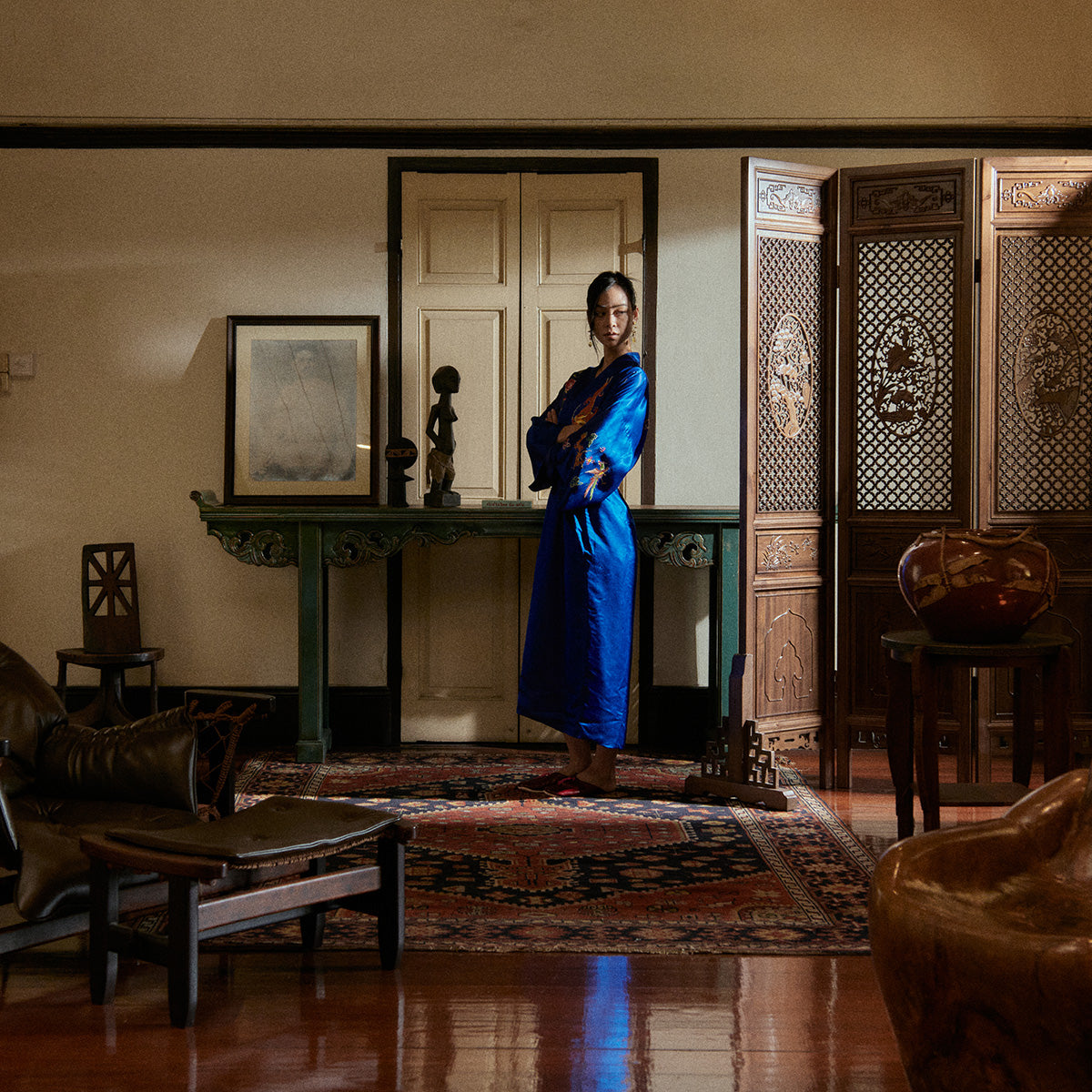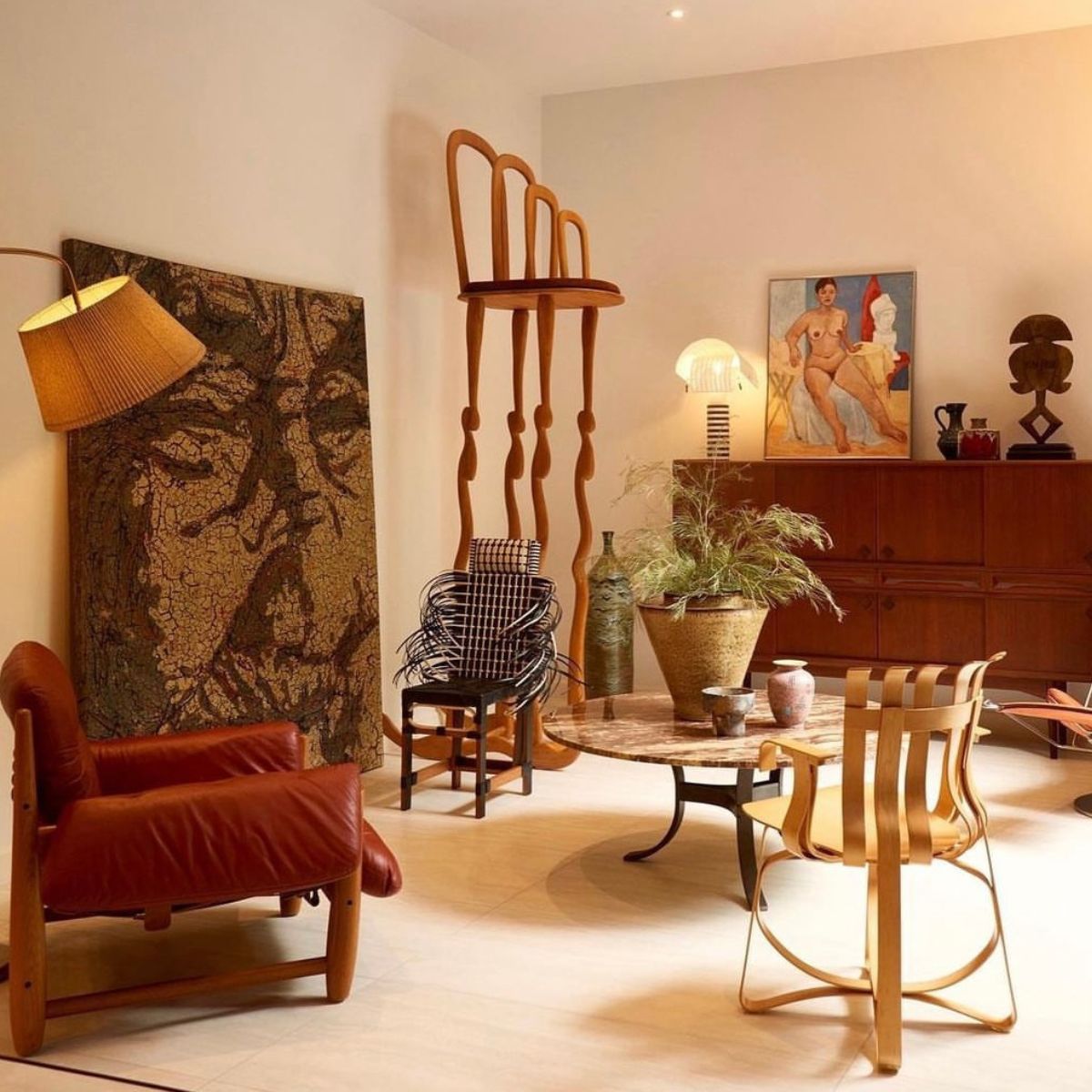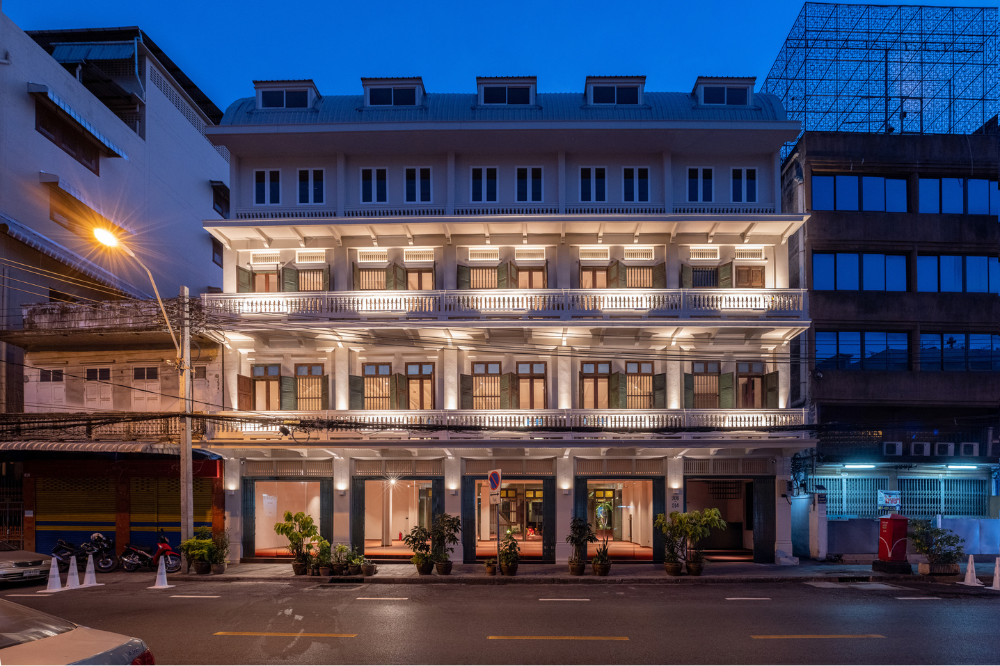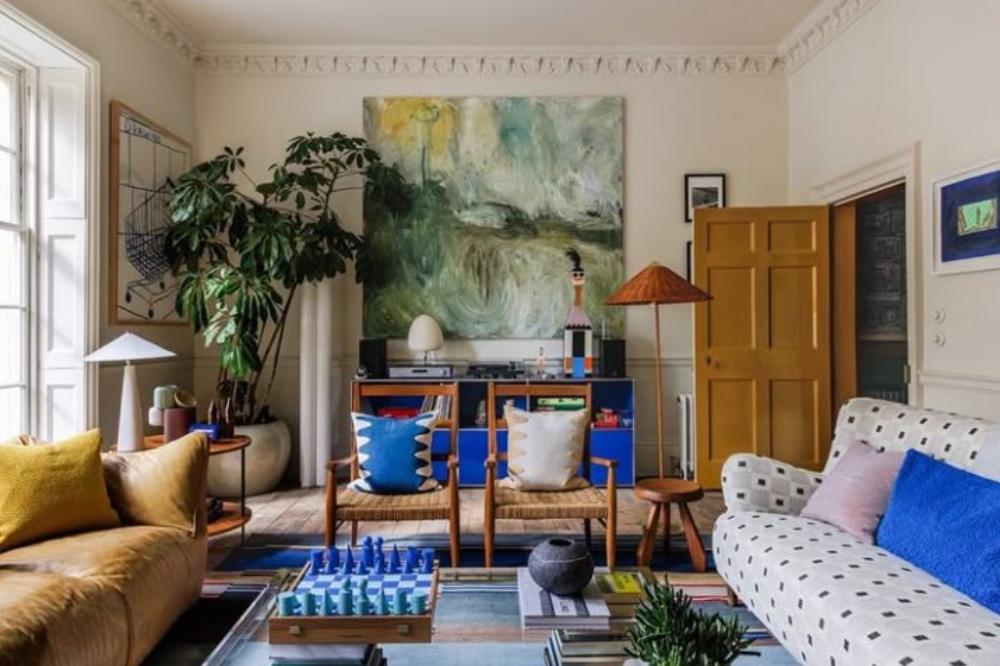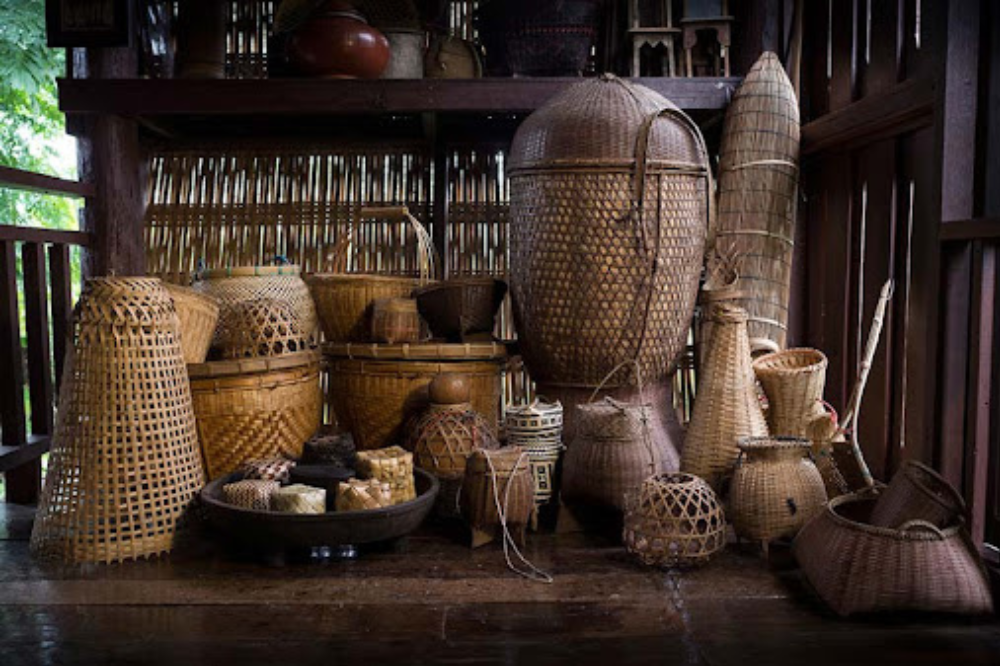In the heart of Bangkok’s Chinatown, down a narrow side alley humming with history, a traditional family home has been reimagined as one of the city’s most compelling cultural destinations. Baan Trok Tua Ngork (บ้านตรอกถั่วงอก), originally built Circa 1920s—affectionately named after the alley it sits on — is a century-old residence transformed into a dynamic venue for dining, art, and design. At its helm are four siblings and co-founders—Win, Sun, Sandy, and Sea Assakul—whose personal connection to the building runs as deep as the structure’s weathered brickwork. When we sat down with the quartet behind this visionary revival, they spoke candidly about the years-long renovation process, their mission to preserve heritage while embracing the contemporary, and their careful curation of tenants, events, and collaborations—including their partnership with Surround Living. What emerged is a story not just of architectural restoration, but of memory, values, and the bold reinvention of legacy for a new generation.

The Renovation Process – Giving Memory a New Form
At first glance, Baan Trok Tua Ngork appears frozen in time: a stately five-story structure with teak windows, hand-laid brickwork, and a sun-drenched courtyard evoking its early 20th-century roots. Yet in the years before its revival, the building had quietly slipped into the background of family life. Once the heart of Chinese New Year gatherings, ancestral rites, and the cousins’ childhood memories, it became a place beloved but rarely visited - “The structure was still beautiful—but it needed care, attention, a reason to be lived in again.”
Rather than let it fade into nostalgia, the next generation—Win, Sun, Sandy, and Sea—chose to revive Baan Trok by deepening its connection to the past. “This was never only about renovating a property,” says Sun, who leads creative direction. “It was about honouring our great-grandmother’s legacy while creating something that could stand on its own today.”
Baan Trok Tua Ngork was thoughtfully renovated between 2020-2022, marking a new chapter in the life of the 90-year-old shophouse. Win (eldest), an architect by trade, led the design and construction with a philosophy rooted in clear contrast—preserving original elements while introducing contemporary interventions with intention and clarity, while new interventions were intentionally modern. “We didn’t want to blur the line,” he explains. “We wanted it to be obvious what was original and what was added.” Teak windows and balustrades were carefully retained, while non-structural walls were removed to create expansive, flowing spaces. Where wood once stood, glass now welcomes light; where brick once crumbled, it now stands proudly exposed.
Partnering with preservation experts Vernadoc, the team mapped every layer of the building’s history, identifying key materials and forms worth saving. This guided a balance between conservation and adaptability, allowing the space to evolve while retaining its soul. “We didn’t want a museum,” Sun notes. “We wanted a living space—somewhere people could eat, gather, dream.”
The resulting aesthetic is bold and deliberate: vintage bricks meet contemporary steel; warm wood balances sleek finishes. Rather than mimic the old, the renovation celebrates the tension between past and present—a visual dialogue where legacy and progress coexist.
What was once an aging family home is now a beacon of thoughtful restoration. “For us, it wasn’t just about preserving a building,” says Sandy. “It was about preserving a feeling—and creating new ones for generations to come.”

Core Values Behind the Vision – A Philosophy in Practice
The transformation of Baan Trok Tua Ngork wasn’t just architectural—it was guided by a clear set of values shaping every decision from design to daily operations. For the founders, reviving their family home meant more than restoration. It meant doing so with intention. Through debate, collaboration, and iteration, five guiding principles emerged: authenticity, originality, progression, owner involvement, and synergy.
“We didn’t start with these values written down,” Win reflects.“They emerged organically as we worked together—and eventually we realised they were already in us.”
Authenticity is central. Rather than chasing aesthetic trends, the team grounded decisions in the building’s history and the family’s story. “We weren’t trying to make something that looked like ‘heritage’, we were trying to be true to this specific place,” says Win. That meant preserving imperfections, celebrating patina, and resisting the polish of generic modernity.
Originality, too, doesn’t mean reinvention for its own sake. “In today’s world, originality is almost impossible if you define it as something never done before,” says Sun. “But for us, it’s about creating from our own lived experience.” This mindset inspired bold decisions—like collaborating with Mexican and Burmese restaurants; (‘Delia’ & ‘Namsu’) or turning the fourth-floor café into a shoppable design space with Surround Living.
Progression ensures the house doesn’t become a monument. “Heritage can’t survive if it’s static,” says Sea. Programming, events, and design constantly evolve. Guests might sip cocktails in a minimalist bar one floor and browse antiques in a sun-drenched café on another. “We’re always asking, what can this be next?” Sun adds.
Owner involvement grounds these ambitions. The founders are visibly present—curating events, solving issues, greeting guests. “You have to be close to the work to protect the vision,” says Sandy. That hands-on presence builds trust and keeps the space alive with care.
Synergy extends beyond the building. Situated in Bangkok’s historic Yaowarat district, the siblings were mindful of their impact. “Even though it’s our family’s building, we’re bringing new energy into an old neighbourhood,” says Sun. That meant considering noise, parking, and local rhythms. Internally, synergy shapes tenant relationships through flexibility, shared programming, and mutual growth. “We want to grow with our community, not against it.”
In finance, Sea takes a balanced approach. “We use numbers to check our direction,” he explains, “but they don’t determine our soul.”Tenancy models, pricing, and even café menus reflect a blend of sustainability and experimentation.
Operations follow suit. Sandy recruits team members who align creatively and bring curiosity. “We want people who think differently,” she says. “People who bring their whole selves to the table.” Like its architecture, the team culture is layered, collaborative, and rooted in mutual care.
Authenticity, originality, progression, owner involvement, and synergy form the architecture behind the architecture—a framework upon which each decision rests. As Baan Trok continues to evolve with new residencies, exhibitions, and collaborations, these values serve as its compass.
“We never set out to be a template,” says Win. “But if this inspires someone to preserve a family home, take a creative risk, or build with care—that’s a future we’re proud to be part of.”

Curating Culture – Tenants, Collaboration, and the Baan Trok Ecosystem
The transformation of Baan Trok Tua Ngork isn’t only architectural—it lives in the energy coursing through the space today, thanks in large part to a thoughtfully curated roster of tenants. From the outset, the founding cousins approached curation not as a leasing task, but as a form of cultural storytelling. The result is a vertical community that redefines what a destination in Bangkok’s Yaowarat can be: rooted in heritage, rich in flavour, and boldly forward-facing.
Each of Baan Trok’s main tenants—Delia, Namsu, and Messenger Service Bar—was selected for their potential to deepen the building’s narrative. In a district already steeped in culinary and architectural tradition, the goal was not to replicate what already existed. “We didn’t want to compete with what already exists,” says Sun. “We wanted to offer what didn’t.”
Delia, a refined Mexican restaurant led by chef Gabriela Espinosa, occupies the ground floor. The collaboration began serendipitously, following Sun’s trip to Mexico City where he saw parallels between Mexican and Thai cuisines—both rich in spice, story, and regional identity. Upon being introduced to Gabby, the connection was immediate. She stepped into the building and felt at home. At first glance, Delia might seem an unlikely fit for a century-old Thai-Chinese house, but its presence makes a statement. “Delia represents so many of our values,” says Wyn. “Authenticity—Gabby brings her heritage into every dish. Originality—no one else is doing what she’s doing at this level in Bangkok. And progression—placing this in Chinatown breaks assumptions in the best way.”
Upstairs on the second floor is Namsu, a restaurant inspired by Myanmar’s Shan State. Its origin traces back to a trial-phase pop-up with chefs Tat and Izzy from Rangoon Tea House. The energy they brought was unmistakable. “We knew, this is what we need more of,” Sun recalls. Namsu brings Shan heritage boldly to Bangkok—offering dishes that feel both novel and familiar.

On the third floor, Messenger Service Bar reimagines the cocktail bar as a space of precision and experimentation. Distinctly different from Chinatown’s frequent speakeasies, it evokes a minimalist science lab where bartenders function like chemists. Flavours are extracted, not just mixed. The bar’s aesthetic—clean, clinical, and curious—creates deliberate contrast with the building’s historic bones.
This kind of tenant selection took time and intention. “We really ate and drank our way through the city,” Sun jokes. But the approach was deliberate: tenants weren’t just renters—they were co-creators in a cultural ecosystem.
The building’s layout supports a uniquely walkable journey. Visitors can move between floors—dining at Namsu, enjoying cocktails upstairs, browsing art and furniture above—creating a vertically integrated experience. “We wanted the experience to unfold like a story,” says Sandy. “Each floor adds a chapter.”

The Living Room – A Treasure Trove and Cultural Lounge
Perched on the fourth floor of Baan Trok Tua Ngork, above the layered culinary worlds of Delia, Namsu, and Messenger Service Bar, sits a serene, light-filled space that distills the building’s core values into one room. Aptly named ‘The Living Room’, it wasn’t part of the original plan—it was meant to be a bar, an extension of Baan Trok’s nightlife. But as with much of the project, the idea evolved in response to its surroundings.
“When we stood on this floor and looked out over the neighbouring residences, we realised a bar just wouldn’t work,” says Sun. “Not in the long term, and not if we wanted to respect the environment around us.”
So the team pivoted, embracing daytime rhythms and flexibility. The result is one of Baan Trok’s most defining innovations: a multi-functional space that serves as café, gallery, design lab, and curated showroom.
“We wanted The Living Room to be where the soul of Baan Trok culminates,” says Win. “A place that brings together our design philosophy, values, aesthetic, and love of community.”
As the only space fully designed and operated by the founding team, The Living Room became a creative playground. “This was the last floor we could really claim for ourselves,”says Sea. That’s when the collaboration with Surround Living came to life — “We wanted a turned up volume on everything Baan Trok stands for. We embraced the juxtaposition between old and new, blending new & old materials, all articulated through a deliberate visual language
“Furniture played a central role. Early in the process, the team kept coming across standout pieces — timeless, crafted, and perfectly in tune with their aesthetic. "They had soul and craftsmanship”, recalls Sun. “We knew instantly they’d align with our vision”. The source? Surround Living.”
That affinity led to a formal collaboration. The Bangkok-based platform, known for curating vintage and design-forward furnishings from across Asia and beyond, helped bring the space to life.“Just like we revived this building, Surround Living revives objects,” says Sandy.“It was a perfect match.”
Curation was a collaborative process—mock floor plans and sketches guided every choice, from low linen sofas, vintage coffee tables to one-of-a-kind Qing dynasty cabinets and bespoke decor items. Even the artwork and ceramics are part of a living catalogue: for sale, and ever-changing.
“We wanted to create a shoppable café, but not in a commercial way,” says Sun. “It’s a space where people can sit, work, talk, and fall in love with an object because they lived with it—even just for an afternoon.”
The Living Room also plays a practical role. As the daytime anchor, it brings early foot traffic and rounds out the building’s rhythm from morning to night. “We wanted the building to have a heartbeat from morning to night,” says Sea.“And this space completes that arc.”
It has since evolved into an event and residency hub, hosting artist talks, workshops, product launches, and rotating exhibitions. Upcoming programs will welcome designers to use the space as both studio and public platform.“This is our cultural test kitchen,” says Sun. “It’s where we keep things dynamic.”
Even behind the scenes, Surround Living’s contribution was key. In a heritage building with narrow stairs and fragile materials, installation logistics matter. “The white-glove delivery was one of the smoothest we’ve ever experienced,” Win notes. “Everything was handled with care and respect—for the pieces and the building.”
Months into its opening, The Living Room has become a destination for design lovers, creatives, and locals seeking calm. Its photos circulate online, but it’s the lived experience that resonates.

Heritage, Longevity, and the Vision Ahead
If Baan Trok Tua Ngork is a building reborn, its future is not a fixed destination but a dynamic continuum. For the four siblings the renovation was only the beginning. Their vision extends beyond architecture to imagining Baan Trok as a cultural anchor, creative incubator, and sustainable model for heritage revival in Bangkok.
“There’s so much untapped potential in Bangkok’s historical buildings,” says Win. “But most people either freeze them in time or tear them down. We wanted to create a third path.”
Thailand’s flexible preservation laws leave many buildings vulnerable. Rather than view this as a loophole, the team embraced it as responsibility.
“The onus is on us to set the tone,” says Sun. “If we do this right, maybe others will see that preservation and progress don’t have to be at odds.” That mindset has made Baan Trok more than a beautifully restored building. It’s a living case study in how values, design, and community can converge. It’s also a viable business—one designed to last.
Sustainability drives both form and function. The multi-tenant model creates steady revenue; the café and events keep the space active beyond mealtimes. A creative residency launching in 2025 will deepen Baan Trok’s cultural programming.
But beyond strategy, it’s personal.
“We’re here every day,” says Sandy. “It’s our workplace, our responsibility, and our family legacy.”
That hands-on ethos shapes everything—from tenant selection to daily logistics. It also guides their relationship with the surrounding community. Aware that they’re introducing new energy into a long-standing neighbourhood, the cousins have chosen respect and collaboration.
“We didn’t want to disrupt the area’s character,” says Sun. “Instead, we’re working within it—architecturally, culturally, socially.” This elasticity is part of Baan Trok’s strength. It can adapt with the times, the seasons, and the community’s needs. And for the founders, the work is far from over.
Plans for the future include expanded programming, new partnerships, and the continued evolution of The Living Room as a cultural venue and shoppable design space. They also hope to inspire broader conversations about heritage in Southeast Asia—through talks, exhibitions, and transparent documentation of their process.
There’s quiet poetry in the fact that the cousins who once ran through the upper floors as children are now shaping Baan Trok’s next chapter. They’ve brought it full circle—not by preserving the past in amber, but by turning it into something vibrant and relevant.
Today, Baan Trok is many things: a destination for design lovers, a community touchstone, and a platform for experimental creativity. But at its core, it remains what it has always been — a home.
Shop Surround Living x Baan Trok Collection Here
